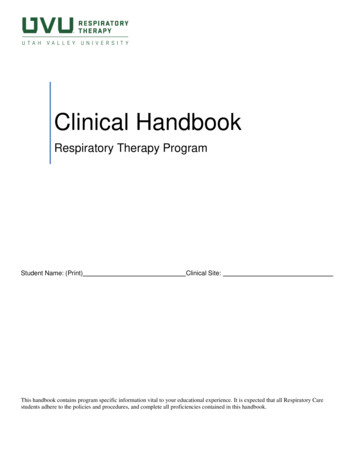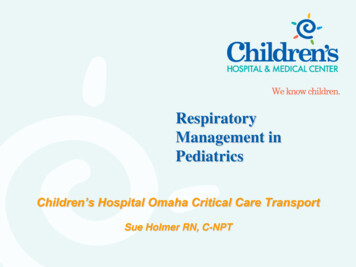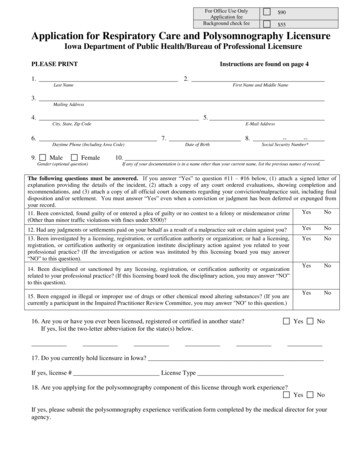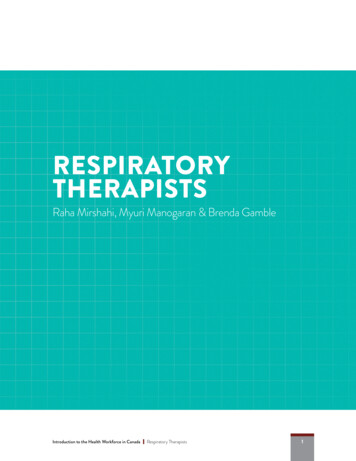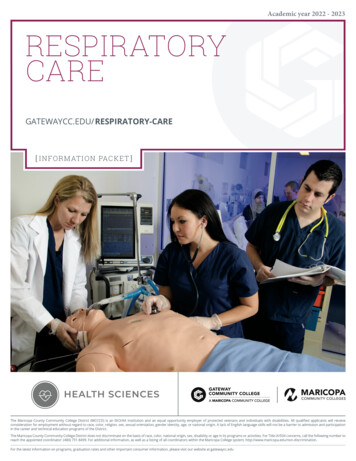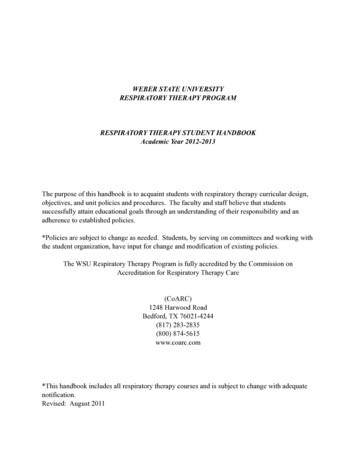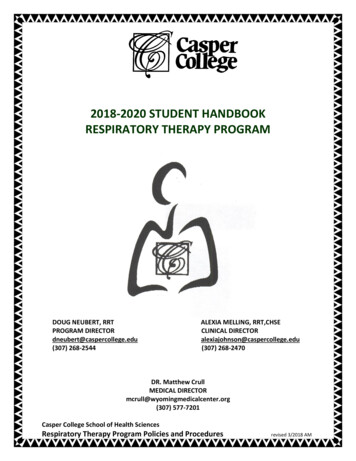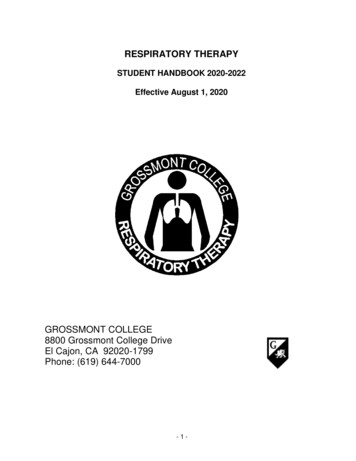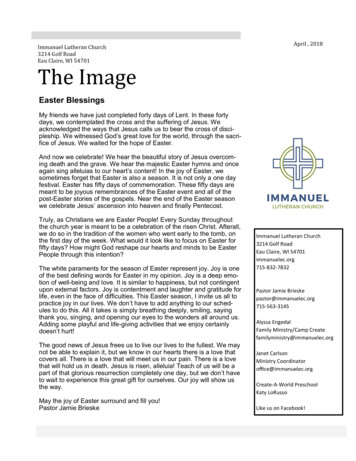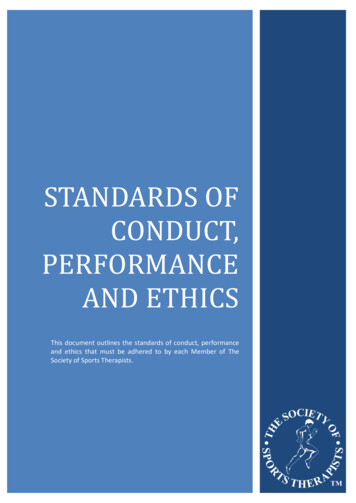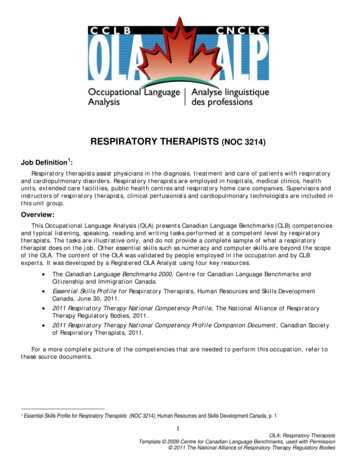
Transcription
RESPIRATORY THERAPISTS (NOC 3214)Job Definition 1:Respiratory therapists assist physicians in the diagnosis, treatment and care of patients with respiratoryand cardiopulmonary disorders. Respiratory therapists are employed in hospitals, medical clinics, healthunits, extended care facilities, public health centres and respiratory home care companies. Supervisors andinstructors of respiratory therapists, clinical perfusionists and cardiopulmonary technologists are included inthis unit group.Overview:This Occupational Language Analysis (OLA) presents Canadian Language Benchmarks (CLB) competenciesand typical listening, speaking, reading and writing tasks performed at a competent level by respiratorytherapists. The tasks are illustrative only, and do not provide a complete sample of what a respiratorytherapist does on the job. Other essential skills such as numeracy and computer skills are beyond the scopeof the OLA. The content of the OLA was validated by people employed in the occupation and by CLBexperts. It was developed by a Registered OLA Analyst using four key resources: The Canadian Language Benchmarks 2000, Centre for Canadian Language Benchmarks andCitizenship and Immigration Canada.Essential Skills Profile for Respiratory Therapists, Human Resources and Skills DevelopmentCanada, June 30, 2011.2011 Respiratory Therapy National Competency Profile, The National Alliance of RespiratoryTherapy Regulatory Bodies, 2011.2011 Respiratory Therapy National Competency Profile Companion Document, Canadian Societyof Respiratory Therapists, 2011.For a more complete picture of the competencies that are needed to perform this occupation, refer tothese source documents.1 EssentialSkills Profile for Respiratory Therapists (NOC 3214), Human Resources and Skills Development Canada, p. 11OLA: Respiratory TherapistsTemplate 2009 Centre for Canadian Language Benchmarks, used with Permission 2011 The National Alliance of Respiratory Therapy Regulatory Bodies
How to Read this Occupational Language Analysis:The titles, numbers and sequence of categories are based on the Canadian Language Benchmarks 2000,which address four major skill areas Speaking, Listening, Reading and Writing. CLB competencies (languagedescriptors) are entered at the left margin and followed by a number indicating the benchmark level (1 – 12)for each competency. Sample occupational tasks (work/task descriptors)drawn from the Essential SkillsProfile or the National Occupational Standards are indented and italicized underneath each competency andreferenced to their source, as follows:Task SourceReferenceExampleEssential Skills ProfileES the first letters of the profilesection(ES-DU) Essential Skills Profile, Document Use sectionNational CompetencyProfileNCP section subsection(NCP-1.1) National Competency Profile, Section 1;Subsection 1National CompetencyProfile CompanionDocumentNCPCD page number code(NCPCD-25-P1.1.1) Companion Document-page 25, task# P1.1.1Comparative Ratings:The following chart compares typical and most complex essential skills ratings for respiratory therapists,based on the Essential Skills Profile, to the corresponding range of CLB ratings, as suggested in RelatingCanadian Language Benchmarks to Essential Skills: A Comparative Framework 2. These are general rangesand there may be some language tasks that fall outside of this range. Just to point out for learning:Skill AreaTypicalMost ComplexEssential SkillsCLBEssential SkillsCLBSpeaking1-35 - 1039 - 10Listening1-35 - 1039 - 10Reading2-46 - 103-47 - 10Writing1-34-838Common Conditions of ModeDescription-locating, collecting, monitoring, interpreting data; establishing and followingschedules; taking and giving directions; consulting; advising/explaining/teaching;creating and maintaining records; reporting; invoicing-patients/clients; families; supervisors; co-workers; medical personnel-hospitals, clinics, health units, extended care facilities, public health centres andrespiratory home care companies where the situation can range from quiet, calm androutine to dynamic, unpredictable emergency situationsspecialized, technical and detailed; predictable and routine to unpredictable and fastpaced; often concrete and sequentialface-to-face; by phone; via computer; videoconferencing; public address systems;pagers-2Relating Canadian Language Benchmarks to Essential Skills: A Comparative Framework; Centre for CanadianLanguage Benchmarks, 20052OLA: Respiratory TherapistsTemplate 2009 Centre for Canadian Language Benchmarks, used with Permission 2011 The National Alliance of Respiratory Therapy Regulatory Bodies
Skill: SpeakingI. Social InteractionInterpersonal CompetenciesGreet, introduce self and ask about the other person. (CLB 3) speak to patients’ families (ES-OC)Open, maintain and close a short routine formal conversation. (CLB 6) use professional and respectful language (NCP-1.1)Respond to a minor conflict or complaint. (CLB 8) speak to department heads of care units to resolve conflicts involving patient care and services (EC-OC) employ conflict resolution strategies in a clinical setting (NCPCD-28-P2.8.4)Comfort and reassure a person in distress. (CLB 8) may speak to family members during cessation of life support. They reassure family members and confirm that their lovedones are not experiencing discomfort. (ES-OC)Conversation ManagementIndicate non-comprehension. (CLB 5) ask their supervisors for clarification (when observing) demonstrations of equipment and new procedures such as propertyventilating newborns (ES-OC)Use a number of strategies to keep the conversation going: hold the floor; resume after interruption; change topic. (CLB 7) minimize communication barriers (NCPCD-27-P2.1.3)Manage conversation. Check comprehension. (CLB 8) validate the patient and/or caregivers comprehension of the instructions (NCPCD-36-P7.1.4)Contribute to/co-manage a discussion or debate in a small formal group (work meeting, seminar). (CLB 9) participate in a formal discussion about work processes or product improvement (ES-WWO)Phone CompetenciesTake phone messages with three to five details. (CLB 6) (use) a telephone (ES-OC)II. InstructionsGive a set of instructions dealing with simple daily actions and routines where the steps are not presented as a point-formsequence of single clauses. (CLB 6) orient new employees (ES-WWO) orient students and new staff (NCP-5.7)Give clear instructions and directions related to moderately complex familiar technical and non-technical tasks. (CLB 7) provide (patients) with instructions. For example, they provide patients with pre-test instructions and inquire about theircomfort levels during cardiopulmonary function tests. Respiratory therapists provide instructions on safe use of home oxygenequipment and explain medical disorders for which patients are receiving treatment. (ES-OC) explain the purpose and process for sputum induction (NCPCD-43-P10.1.1) inform non-ventilated patient and caregivers with respect to transport procedure and care during out-of-hospital transfer(NCPCD-71-P14.15.5) prepare patient for: ECG recording and/or monitoring (NCPCD-74-16.1.6); evaluation of pulmonary mechanics (NCPCD-7617.1.7); flow/volume measurement (NCPCD-77-17.3.10); lung volume, airway resistance and conductance measurement bybody plethysmography (NCPCD-77-17.4.7); FRC measurement (NCPCD-78-17.5.6); pulmonary diffusion capacitymeasurement (NCPCD-78-17.6.6); bronchoprovocation testing (NCPCD-78-17.7.7) (etc.) prepare/teach the patient for peak flow measurement in a clinical setting (NCPCD-79-17.11.4)Give/pass on instructions about an established familiar process or procedure (technical and non-technical). (CLB 8) assign specific tasks to team members (ES-JTP) inform other workers or demonstrate to them how tasks are performed (ES-WWO)3OLA: Respiratory TherapistsTemplate 2009 Centre for Canadian Language Benchmarks, used with Permission 2011 The National Alliance of Respiratory Therapy Regulatory Bodies
Give clear, detailed oral information to someone to carry out complex multi-step instructions for a familiar technical/nontechnical process. (CLB 9) explain [the process of physical respiratory] assessment to patients (NCPCD-38-P8.2.9)III. Suasion (Getting Things Done)Request, accept or reject goods or services, assistance or offer in a service or sales situation. (CLB 4) collect payment from clients. For example, respiratory therapists employed by oxygen supply companies may collect paymentand provide change for deliveries of oxygen therapy equipment and supplies. (ES-NU)Make a simple formal suggestion; provide reason. (CLB 6) make suggestions on improving work processes (ES-WWO) recommend course of action [related to medication] (NCPCD-41-9.5.3)Make an extended suggestion on how to solve an immediate problem or make an improvement. (CLB 7) (speak with) uncooperative patients. For example respiratory therapists encounter patients who refuse to wear equipment(ES-PS) explain the function of the equipment and suggest adjustments that can be made to make wearing equipment such as masksmore comfortable (ES-PS)IV. InformationPresentationsDescribe a moderately complex process. (CLB 7) use recognized medical terminology (NCP-2.4)Give a presentation to describe and explain a complex structure, system or process based on research. Use a diagram tosupport the explanations. (CLB 8) provide cardio-respiratory education to patients/clients, family members community advocates and/or other healthcareprofessionals (NCP-7.1) teach incentive spirometry (NCP-10.12) share research findings [with colleagues] (NCPCD-36-P6.2.4) promote and teach tobacco smoking cessation (NCPCD-37-P7.2.3) describe potential complications associated with the administration of substances [e.g., drugs, fluids] by inhalation (NCPCD41-P9.8.6); by injection (NCPCD-42-9.9.4); by instillation including monitoring of patient response (NCPCD-42-9.10.4); byinfusion (NCPCD-42-9.11.3)Interaction One-on-OneAsk for and provide information related to routine daily activities (e.g., personal, family, others, work). (CLB 5) discuss ongoing work with co-workers. For example, they provide their shift replacements with updates on patients and theircare plans. They inform their co-workers of malfunctioning equipment and possible resolutions. They discuss shift andappointment coverage and general work schedules. (ES-OC) (work) with home care companies [to] plan their days and tasks to complete pre-scheduled appointments (ES-JTP)Ask for and provide detailed information related to personal needs, varied daily activities and routine work requirements.(CLB 7) discuss medical conditions with patients for example, (respiratory therapists) interview patients to gather health historiesand understand their symptoms (ES-OC) explain [process of physical respiratory] assessment to patient (NCPCD-38-P8.2.9) instruct patient on: assisted cough maneuvers and monitor application in a clinical setting (NCPCD-45-P10.10.2); effectivesecretion clearance techniques (NCPCD-45-P10.11.3); applying effective breathing techniques (NCPCD-45-P10.11.6); usingincentive spirometry (NCPCD-46-P10.12.3); instruct patients ready for speech therapy in a clinical setting (NCPCD-54-P11.31.3)Ask for and/or provide detailed information related to personal needs, varied daily activities and routine work requirements.(CLB 8) inform (surgeons and anesthesiologists) of vital sign readings and flow rates (ES-OC)4OLA: Respiratory TherapistsTemplate 2009 Centre for Canadian Language Benchmarks, used with Permission 2011 The National Alliance of Respiratory Therapy Regulatory Bodies
Provide, obtain and discuss detailed complex information and opinions with individuals in order to coordinate teamworkassignments/tasks. (CLB 9) discuss medical diagnoses and patient care with other health professionals. For example, respiratory therapists speak to othermedical practitioners about patients' assessments, test requisitions and results, and treatment protocols. They seekclarification of treatment orders such as care for patients who have 'do not resuscitate' orders. (ES-OC)Provide, obtain and discuss detailed complex information and opinions with an individual in a peer or superior relationship inorder to coordinate work train in established procedures, delegate, solve a problem or conflict, or make a decision. (CLB 10) speak to department heads of care units to resolve conflicts involving patient care and service (ES-OC)Interaction in a GroupParticipate in a small group discussion. (CLB 5) apply effective verbal communication skills in a clinical setting (NCPCD-27-P2.1.4) utilize effective non-verbal communication techniques in a clinical setting (NCPCD-27-P2.1.9)Participate in a small group discussion/meeting on non-personal familiar topics and issues: express opinions, feelings,obligation, ability, certainty. (CLB 6) participate in role-playing exercises based on self-appraisal in a simulated context (NCPCD-26-P1.7.3) participate in the orientation for students and new staff to a respiratory care department in a clinical setting (NCPCD-35P5.7.2) demonstrate effective team interaction and communication during resuscitation (NCPCD-73-15.4.9)Participate in a small group discussion/meeting: express opinions and feelings; qualify opinion, express reservations,approval and disapproval. (CLB 7) work as members of multi-disciplinary teams in a coordinated effort to manage the ongoing health of patients. They work withphysicians, their supervisors and other medical personnel to ensure patients are tested and treated for various types ofcardiopulmonary diseases. (ES-WWO) participate in professional consultations in a multidisciplinary and/or interdisciplinary health care system (NCP-2.6) participate in institutional/organizational and/or professional body/association meetings/committees (NCP-5.2) participate in community health programs (NCP-7.3) communicate your assessment findings with the team on a ongoing basis in a clinical setting (NCPCD-73-15.5.4)Participate in a debate/discussion/meeting on an abstract familiar topic or issue. (CLB 8) participate as a patient advocate in a clinical setting (NCPCD-37-P7.4.2)5OLA: Respiratory TherapistsTemplate 2009 Centre for Canadian Language Benchmarks, used with Permission 2011 The National Alliance of Respiratory Therapy Regulatory Bodies
Skill: ListeningI. Social InteractionIdentify verbal and non-verbal details of social exchanges, including styles of greetings, leave-taking and introductions. (CLB3) demonstrate effective nonverbal communication skills (NCP-2.1)II. InstructionsUnderstand a range of spoken everyday instructions on step by step procedures. (CLB 5) receive instructions and directions from supervisors and managers (ES-OC) receive and transcribe verbal orders (NCP-2.9)Follow an extended set of multi-step instructions on technical and non-technical tasks for familiar processes or procedures.(CLB 8) receive directions from surgeons and anesthesiologists before and during surgical procedures (ES-OC)III. Suasion (Getting Things Done)Demonstrate comprehension of factual details and some inferred meanings in simple advice and suggestions,announcements and commercials. (CLB 5) listen to hospital paging systems. For example, they listen to emergency code calls to determine the nature of emergencies.(ES-OC)Demonstrate comprehension of details and speaker’s purpose in suggestions, advice, encouragements and requests. (CLB 6) employ active listening techniques in a clinical setting (NCPCD-27-P2.3.3)IV. InformationIdentify main ideas, supporting details, statements and examples in a descriptive or narrative presentation, or in a groupinteraction (e.g., meeting, discussion). (CLB 6) (learn) on the job and through interactions with co-workers and supervisors; through training offered in the workplace (ESCL) participate in professional development/continuing education activities during clinical stage (NCPCD-26-1.6.4)Identify facts, opinions and attitudes in conversations about abstract and complex ideas on a familiar topic. (CLB 8) conduct a comprehensive patient/client history (e.g., environmental, resources, equipment, safety, home evaluation,occupational evaluation, psycho-social, familial and medical history) (NCP-8.1)6OLA: Respiratory TherapistsTemplate 2009 Centre for Canadian Language Benchmarks, used with Permission 2011 The National Alliance of Respiratory Therapy Regulatory Bodies
Skill: ReadingI. Social Interaction TextsNo communication tasks for this category were found in the source documents. These tasks may, in fact, exist for this occupationand will require individual assessment in each work context.II. InstructionsFollow a set of common everyday instructions (up to 10 steps) when not presented completely in point form: sequence/ordermust be inferred. (CLB 6) read e-mail which describe special techniques surgeons intend to use for upcoming surgical procedures and messages fromanaesthesiologists about the equipment they require (ES-RT)Follow coherent extended instructional directions. (CLB 8) read equipment, policy and procedure manuals. For example, they read manuals for new equipment to understand operatingand troubleshooting procedures. They may use this information to prepare learning guides and training materials for theequipment. (ES-RT) [read and] adhere to professional medical, legal, and ethical guidelines/regulations (NCP-1.4) [read and] adhere to institutional/organizational policies and procedures (NCP-1.5) [read and] adhere to quality control/assurance guidelines (NCP-4.2) [read and] adhere to Canadian Standards Association (CSA) standards for medical equipment; Department ofTransportation/Transport Canada regulations for cylinders and medical gases; institutional/organizational disaster and masscasualty plan (NCP-4.10) [read and] adhere to professional medical, legal, and ethical guidelines/regulations (NCPCD-26-E1.4)III. Business/Service TextsFind information in formatted texts: forms, tables, schedules, directories. (CLB 4) confirm shift times and operating room assignments on staffing schedules (ES-DU)Identify factual details and some inferred meanings in moderately complex business/service texts, including formatted texts.(CLB 5) verify medical prescription (NCP-9.4)Identify factual details and some inferred meanings in moderately complex texts containing advice, requests, specifications.(CLB 6) read reminder notes and text entries in forms. For example, they read physicians’ entries in patients’ records to becomefamiliar with diagnoses and treatment recommendations, and to learn about unusual conditions that may affect treatmentplans. (ES-RT) scan product, equipment and identification labels for dates, concentrations and other data. For example, they scan labels oninhalers and gas and oxygen canisters to locate expiry dates. Anaesthetic assistants scan coloured labels to identifyparalytics, relaxants and anaesthesia. They then verify trade names and required concentration levels. They matchinformation on patients' wrist identification labels to requisition forms. (ES-DU)Find two or three pieces of information in moderately complex formatted texts. (CLB 6) locate data in lists and tables. For example, they scan various lists to locate co-workers' contact numbers, reviewappointments and confirm supply and equipment inventories. They locate acceptable ranges of blood gases in specificationtables and side effects of medications which patients are using on asthma medications charts, and identify brands. They alsoconfirm their shift times and operating room assignments on staffing schedules. (ES-DU) read charts and medical files (ES-FI)Identify factual details and some inferred meanings in moderately complex texts containing assessments, evaluations,advice. (CLB 7) locate data in entry forms. For example, they scan forms in patients’ charts to verify dates and test results and reviewrequisition forms to confirm patients’ identities and tests ordered. They view testing equipment printouts such as displays ofpatient’s blood gas levels, Holter reports and pulmonary function analyses. Respiratory therapists confirm equipment rentaland consent forms are properly completed and signed by patients. They also review patients’ responses to questionnairessuch as the Epworth Sleepiness Scale and the Continuous Positive Airway Pressure Follow-up forms. Clinical perfusionistsreview pre-anaesthetic forms to determine anaesthesia plans and operating room set-ups. (ES-DU)7OLA: Respiratory TherapistsTemplate 2009 Centre for Canadian Language Benchmarks, used with Permission 2011 The National Alliance of Respiratory Therapy Regulatory Bodies
Identify factual and inferred meanings in written proposed solutions, recommendations and proposals; and in statements ofrules, regulations, laws and norms of behaviour. (CLB 8) read legislation. For example, they may read the Compressed Gas Association’s standards for air quality and Transportationof Dangerous Goods regulations. They may also read provincial health ministries’ qualification criteria and funding applicationprocedures for home oxygen therapies. (ES-RT)IV. Informational TextsDemonstrate comprehension of a two- or three-paragraph moderately complex descriptive or narrative text on a familiartopic. (CLB 5) read entries in communication logbooks. For example, they read about changes to schedules, times and topics for in-servicemeetings, new equipment and changes to procedures (ES-RT)Show comprehension of a one-page moderately complex descriptive/narrative text on a familiar topic. (CLB 6) read their organizations' policies on topics such as contagious infection control, use of personal protective equipment andcleaning and disinfecting equipment. They may read the Pulmonary Function Laboratory Management and Procedure Manualoutlining standard North American procedures for all cardiopulmonary testing. (ES-RT) read memos, letters and e-mail. For example, they read memos from co-workers in their own organizations on topics such aspolicy changes, safety and medical procedures. They read letters from referring physicians which identify patients' medicalconditions and prescribe treatments and therapies. They also read e-mail from colleagues who describe problemsencountered in areas such as cardiovascular care and request possible resolutions for the problems Respiratory therapistsread e-mail about difficulties home oxygen equipment and symptoms patients are experiencing. (ES-RT) read anaesthetic plans and patients’ files (ES-FI) [learn] through reading or other forms of self study (ES-CL)Demonstrate comprehension of a cycle diagram, flow chart and a timeline/schedule. (CLB 6) read schematic diagrams (ES-DU) refer to a variety of diagrams and drawings. For example, respiratory therapists refer to assembly drawings to identify parts,switches and connections on cardiopulmonary testing equipment. Perfusionists and anaesthetic assistants verify cable andtubing connections on basic schematic drawings when troubleshooting malfunctioning heart lung bypass machines andventilators. (ES-DU)Demonstrate comprehension of moderately complex tables, graphs, diagrams, and flow charts. (CLB 7) interpret test results displayed in graph formats. For example, they view patients’ sleep and breathing graphs to determinewhen and what stages apnoeas and hypopnea occur. Clinical perfusionists and anaesthetic assistants monitor heart andbreathing patterns to ensure patients’ safety and comfort. (ES-DU)Trace, summarize and evaluate the development of arguments in complex expository or argumentative texts (e.g., in arational inquiry paper or in a problem-solution paper). (CLB 10) read journal articles and research studies. For example, they may read articles in the Canadian Respiratory Journal, CanadianPerfusion and Chest to become familiar with new treatments for respiratory conditions, diagnostic methodologies, medicalbreakthroughs and new equipment. They may read research studies to remain knowledgeable of advancements in the field.(ES-RT) [read and] evaluate research data, methods, and outcomes with respect to validity and applicability to therapy and diagnosticprocedures (NCPCD-36-E6.3) differentiate published research and results that are relevant to clinical practice (NCPCD-36-P6.3.3)Information Literacy/Reference and Study Skills CompetenciesAccess and locate three or four pieces of information in on-line electronic reference sources (e.g., World Wide Web, librarydatabases), if available, or from print reference sources. (CLB 7) use databases (ES-CU) search their organizations’ databases to access patient information and review test results (ES-CU) use search engines to locate professional association web sites, journals, medical reference pages and information aboutmedical equipment (ES-CU) utilize computer and electronic data management tools in a clinical setting (NCPCD-32-P5.1.3)8OLA: Respiratory TherapistsTemplate 2009 Centre for Canadian Language Benchmarks, used with Permission 2011 The National Alliance of Respiratory Therapy Regulatory Bodies
Skill: WritingI. Social InteractionNo communication tasks for this category were found in the source documents. These tasks may, in fact, exist for this occupationand will require individual assessment in each work context.II. Recording/Reproducing InformationTake notes from an oral presentation or a page of written information. (CLB 6) receive and transcribe verbal orders (NCP-2.7)Write an outline or a summary of a longer text. (CLB 7) write procedural summaries and instruction sheets for co-workers. For example, they may write summaries of procedures fornew testing and treatment methods and instruction sheets for operating and disinfecting new equipment. (ES-W) formulate [in writing] a template for an institutional disaster and mass casualty plan [for personal reference] (NCPCD-33P4.10.2)III. Business/Service MessagesFill out forms. (CLB 5) prepare invoices. For example, respiratory therapists employed by oxygen supply companies may calculate prices of therapyequipment and supplies and apply client-specific mark-ups and taxes. (ES-NU)Convey business messages as written notes. (CLB 5-6) write short notes and reminders. For example, they write notes in communication logbooks to report malfunctioningequipment, request the use of shared resources and describe changes in procedures and staffing schedules (ES-W)Fill out moderately complex forms. (CLB 6-7) complete a variety of checklists and forms. For example, they may enter their observations of students’ capabilities andprogress in performance evaluation forms, note strengths and weaknesses, and make training recommendations. Clinicalperfusionists complete pre-bypass checklists. Respiratory therapists complete scheduled maintenance checklists, ventilatorflow sheets, blood gas summary forms and instruction checklists for new clients. Anaesthetic assistants complete detailedanaesthetic records prior to and during surgery. (ES-DU) enter patients’ demographic data, test results and treatment information (ES-CU) record and track data on equipment, inventory and patients [on spreadsheets] (ES-CU) record levels of anaesthesia and drugs using specialized software programs (ES-CU) maintain documentation and records (NCP-2.5)Convey business messages as written notes to pass on routine information, make requests, or respond to recommendationsand warnings. (CLB 7) write e-mail, memos and letters. For example, they write email to ask co-workers to set up meetings and inform them of safetyand equipment concerns and to suppliers to request product information. They write letters to physicians and palliative carenurses to provide test updates and ask them to reassess patients. (ES-W) formulate [in writing] an objective and effective self performance appraisal template (NCPCD-26-P1.7.2)Convey business messages as written notes, memoranda, letters of request, or work record log entries, to indicate aproblem, to request a change, or to request information. (CLB 8) prepare memos for co-workers, letters to physicians (ES-CU) apply effective written communication skills in a clinical setting (NCPCD-26-P2.1.6)Fill out forms and other materials in pre-set formats with required brief texts. (CLB 8) write entries in patients’ charts. For example, they comment on symptoms, test results, treatments administered, patients’responses and ventilator weaning measurements. Perfusionists and anaethesia assistants record exceptional reactions thatoccurred during surgery. (ES-W) report and chart procedure and patient data in a clinical setting (NCPCD-82-17.18.7)Write letters to request and to respond to requests for information, directions, service/product, clarification, permission. (CLB9) may write memos to instruct patients about medications and use of oxygen equipment (ES-W)9OLA: Respiratory TherapistsTemplate 2009 Centre for Canadian Language Benchmarks, used with Permission 2011 The National Alliance of Respiratory Therapy Regulatory Bodies
IV. Presenting InformationWrite a paragraph to relate/narrate a sequence of events; to describe a person, object, scene, picture, procedure or routine;or to explain reasons. (CLB 5) collect and provide [in writing] workload measurement data (NCPCD-35-E54)Write one or two paragraphs to: relate a familiar sequence of events, tell a story; provide a detailed description andcomparison of people, places, objects and animals, plants, materials, or routines; or to describe a simple process. (CLB 6) utilize medical terminology and abbreviations in a clinical setting (NCPCD-27-P2.4.2)Write two or three paragraphs to narrate a familiar sequence of events from the past; to tell a story; or to provide a detaile
Respiratory Therapists, Human Resources and Skills Development Canada, June 30, 2011. 2011 Respiratory Therapy National Competency Profile, The National Alliance of Respiratory Therapy Regulatory Bodies, 2011. 2011 Respiratory Therapy National Competency Profile Companion Document, Canadian Society of Respiratory Therapists, 2011.

